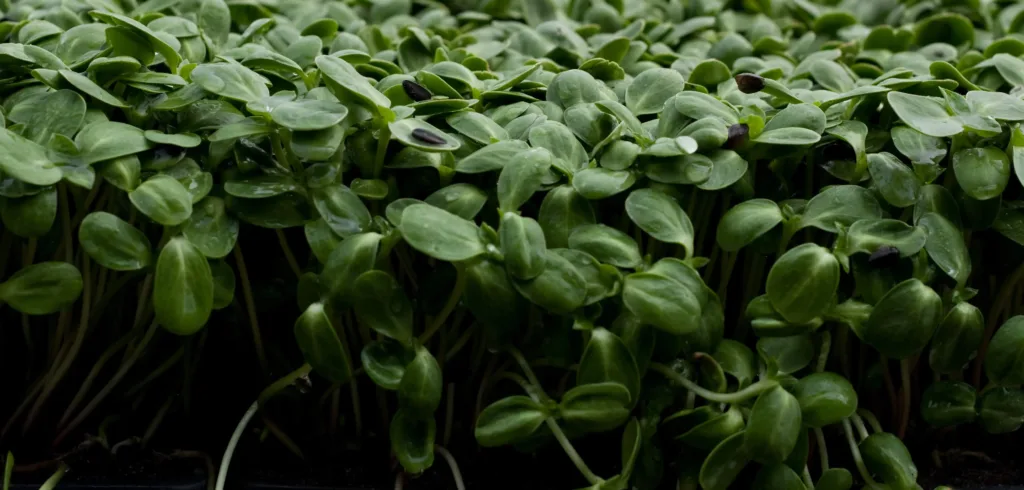Overview
Until relatively recently in human history, all photosynthesis was powered by the sun. But with the invention of electric lights, we can now drive the photosynthetic process without sunlight.
Because most microgreen production systems tend to rely wholly (sole source) or partially (supplemental) on artificial light, a valuable skill for any grower is the ability to measure and control light to help determine and supply the optimum amount and quality of light to your crops.
As consumers, we tend to think of lights in terms of Watts (W) – the amount of power used by the lights, and lumens (lm) – the quantity of light emitted from a light source. When we talk about lights using these terms, we are usually thinking of things like their cost to operate and how they will light up a room or space. But for growing indoor crops, we think of light as an energy source for crops – so the measurements we use are different.
What follows is an overview of the different terms and concepts we will use in this guide, the units we use for measuring photosynthetic light, and some calculations to bring some of the different concepts together.
This topic can be a bit overwhelming at first, so take your time with things here!
Terms
Photosynthetically Active Radiation (PAR)
- This is the electromagnetic radiation range used by plants in photosynthesis, found in the visible light spectrum from 400 nm to 700 nm
Far-Red Light
- Far-red light (700 to 800 nm) is not technically part of the PAR range, but does have an impact on plant growth, especially between 700 nm and 750 nm. Far-red light promotes stem elongation (i.e., stretches your plants) and biomass accumulation.
µmol (micromol)
- A mole is a unit of measurement for particles, with one mole containing 6.022 x 1023 particles. Since the number of photons in the PAR range is enormous, the horticultural industry uses the micromole, which is one-millionth of a mole, or 6.022 x 1017 photons.
Photosynthetic Photon Flux (PPF)
- The measure of how many PAR photons are emitted by a light source.
- Measured in µmol/sec.
Photosynthetic Photon Flux Density (PPFD)
- The quantity of PAR light emitted from a source that reaches a one-meter-square area per second
- Measured in µmol/m2s.
- 1 µmol/m2s = 6.022 x 1017 photons hitting a 1 m2 area each second.
- For context, full sun is about 2000 µmol/m2s
- PPFD is also, in many ways, a measure of how well your light source is reaching your plants. The further you move a light source from your plants, the lower the PPFD will be.
Photoperiod
- The length of time for which a crop receives light each day
- Measured in hours.
Daily Light Integral (DLI)
- DLI is the total amount of light a crop receives per day
- Measured in mol/m2d.
- This is often the starting point for determining lighting needs
Light Proximity
- The distance between your crop and the light source
- Measured in cm
- In theory, the closer your crop is to the light source, the higher the PPFD value. But this can vary depending on your light and reflector set up.
Light Efficiency
- Light efficiency refers to how much PAR you get per unit of energy used, measured in µmol/joule or µmol/W or µmol/kWh. You may be surprised at the variability of lighting efficiency! Take home message: 3 different 30W lights can give you vastly different photon output.
Light Distribution
- A measure of how uniformly light is distributed across your growing space. We want light to be as uniform as possible across a growing space.
Light Quality
- The relative amount of the different wavelengths a light source emits.
Photomorphogenesis
- Photomorphogenesis refers to the effect of light on physical and chemical aspects of your crop which can include stem length, stem strength, leaf size, leaf color, flavor, nutritional content, and many other attributes. The better you understand lighting, the more you can control photomorphogenesis.
Relationships Between Key Terms
There is an important relationship between PPFD, photoperiod, and DLI that we use to make lighting calculations:
PPFD (µmol/m2s) x Photoperiod (hrs/day) x .0036 DLI (mol/m2d)
The addition of “.0036” converts the seconds into hours (multiply by 3600 s/hr) and the µmol into mol (dividing by 1,000,000 µmol/mol). In simpler terms, DLI is determined by the amount of light your plants receive per second x the number of hours of light your plants get each day.
With this overview of terminology now complete, we’ll take a look at how you take measurements in your system in our next blog post.

Leave a Reply